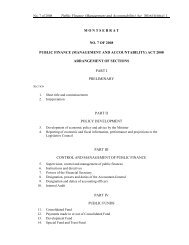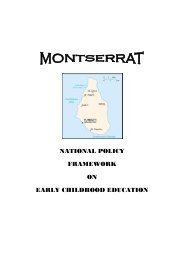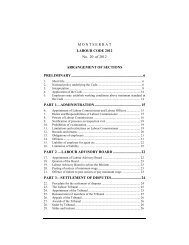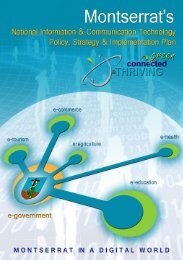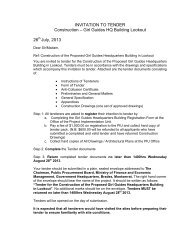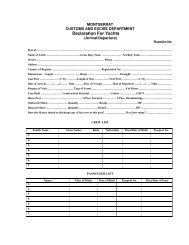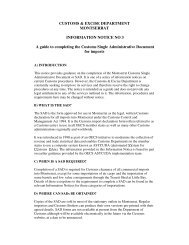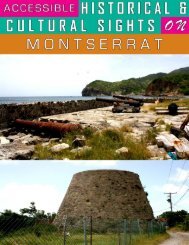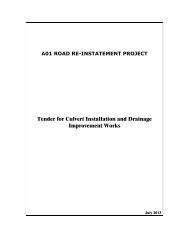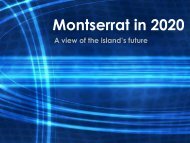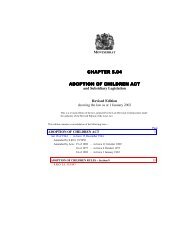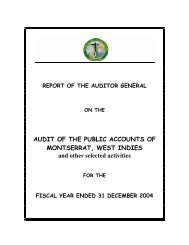Montserrat Survey of Living Conditions (MSLC) Executive Summary
Montserrat Survey of Living Conditions (MSLC) Executive Summary
Montserrat Survey of Living Conditions (MSLC) Executive Summary
You also want an ePaper? Increase the reach of your titles
YUMPU automatically turns print PDFs into web optimized ePapers that Google loves.
<strong>Montserrat</strong> <strong>Survey</strong> <strong>of</strong> <strong>Living</strong> <strong>Conditions</strong><strong>Executive</strong> <strong>Summary</strong>number <strong>of</strong> mentions <strong>of</strong> the words ‘struggling’ and ‘surviving’ in the PPAs. In this sense, the term hardshipis arguably more apposite in the <strong>Montserrat</strong>ian context than poverty.3.8 Changes since 2000Comparisons <strong>of</strong> the 2000 and 2008 PPAs reveal very similar results. This is not unsurprising given thatthey were both undertaken in periods <strong>of</strong> economic hardship. The factors causing these situations arehowever different. In 2000, the country was only beginning to recover from the eruptions while in 2008the economy was contracting due to the global recession and the completion <strong>of</strong> major constructionprojects. Both surveys are dominated by concerns about the high cost <strong>of</strong> living that has imposed a varyinglevel <strong>of</strong> hardship on a large proportion <strong>of</strong> the population. The coping strategies employed to enablepeople to ‘make ends meet’ are virtually identical as are the groups likely to be most vulnerable to severepoverty: the elderly, the mentally challenged and households with single headed families with children.There are however differences although these are a matter <strong>of</strong> degree rather than radical change. Inparticular, it is probable that the psychological impacts <strong>of</strong> the eruption have reduced, given that they arenow living in safe areas and considerable reconstruction has taken place. For instance, respondents arenow more concerned about improving current housing conditions than discussing the failings <strong>of</strong> the posteruptionshelter policy. If the sense <strong>of</strong> insecurity resulting from the eruption has, for many, decreased thisis partly <strong>of</strong>fset by an increase in insecurity resulting from increased immigration, especially during a time <strong>of</strong>economic stagnation. Issues related to unemployment and under-employment receive greater attention forthe same reason. Little attention was paid to migrant issues in 2000.Overall, responses received in the 2008 PPAs are more typical <strong>of</strong> those from other Eastern CaribbeanPPAs than those from 2000 16 . In the future, this is likely to be increasingly the case as memories <strong>of</strong><strong>Montserrat</strong>’s volcanic eruption fade to be increasingly replaced by the issues found in other CPAs –although they will be reawakened every time there is a spate <strong>of</strong> volcanic activity.4 The Institutional Analysis (IA) (Chapters 4 and 5)The objectives <strong>of</strong> the IA were to: (i) to identify the principal policies, programmes and activities relevant topoverty reduction; (ii) to assess the scope and effectiveness <strong>of</strong> these interventions; and hence (iii) toidentify potential recommendations as to how existing activities and can be improved and newinterventions introduced. The IA was undertaken through interviews and discussions with numerousgovernment, non-government and private sector organizations as well as the review <strong>of</strong> relevant documentsand statistics. The IA covered economic, infrastructure and social sectors. Suggestions arising from theIA, <strong>of</strong> which there were many, have been included in the CPA’s recommendations.16 Some <strong>of</strong> the differences may also be due to the different approaches in the two studies. The 2000 surveys wereundertaken just as the concept <strong>of</strong> PPA approach was gaining favour. At that time, poverty was still essentially seen inincome and quantitative terms; hence greater emphasis was given to exploring alternative definitions <strong>of</strong> poverty.Much <strong>of</strong> this is now the orthodoxy so more recent PPAs tend to stress the examination <strong>of</strong> the characteristics,concerns and needs <strong>of</strong> different sub-groups <strong>of</strong> the poor. This facilitates addressing the non-income aspects <strong>of</strong>poverty and deriving policy interventions for different vulnerable groups.<strong>Montserrat</strong> Country Poverty Assessment, Final ReportHalcrow Group Limited, July 2012.ES16




